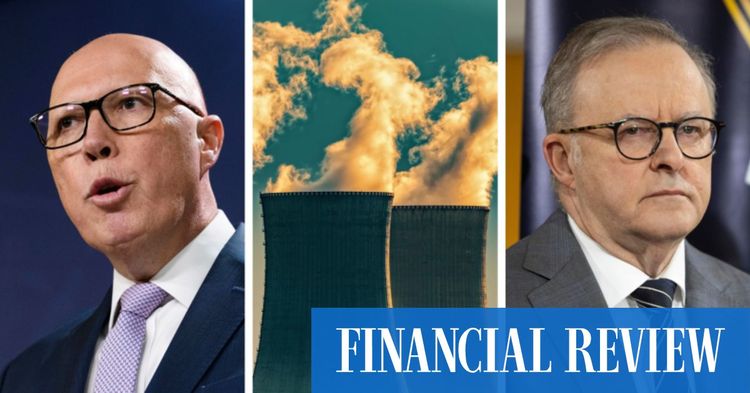Nuclear power: Peter Dutton challenges Anthony Albanese to ...

“It’s a matter of whether the rollout of renewables with solar continues in order to secure energy supply, or whether we just stop all that and wait 15 years for the most expensive form of energy to come online.”
The opposition polled communities in the seven Coalition electorates in NSW, Queensland, Victoria, South Australia and Western Australia which would host the reactors and in all cases, support was over 50 per cent, with the highest at 60 per cent.
It is understood Gippsland, in Victoria, for example, showed 55 per cent support for a reactor on the site of the Loy Yang coal-fired power station.
But business and energy groups expressed fears the policy would delay the energy transition and, if actually implemented, would result in private investment being squeezed out, given the plants would be government-owned enterprises, similar to the Commonwealth-owned Snowy Hydro.
“With no delivery projected until the middle of the next decade, the proposal does not immediately help with short-term emissions reduction or the cost and reliability of energy in the short term,” said Australia Industry Group chief executive Innes Willox in comments which echoed those of other groups.
“The proposition, too, that the federal government own and operate the bulk of electricity generation in Australia raises some red flags. If it effectively renationalises electricity in Australia, there is a risk that private sector investment gets killed off.
“Using public funds for assets that may be uncommercial means more debt, more taxes or more cuts to other spending priorities.”
Under the plan, which was supported without dissent by the Coalition party room on Wednesday morning, there would be five large-scale power plants and two small modular reactors, or SMRs, all in operation by 2050.
Where and whenThe large-scale plants, which would have a capacity of between 1 gigawatt and 1.4 gigawatts, would be built on the site of old coal-fired power stations in Lithgow (Mt Piper) and the Hunter Valley (Liddell) in NSW, Traralgon in Victoria (Loy Yang), and Mount Murchison (Callide) and Tarong in Queensland.
The SMRs, which are still a concept technology, would be built at Port Augusta in South Australia, and Collie (Muja power station) in Western Australia.
The first plant would be producing power by 2035 if it was an SMR, or 2037 “if modern larger plants are found to be the best option”.
Nationals frontbencher Perin Davey said if a community was “absolutely adamant then we will not proceed” but she was overruled by her leader David Littleproud who said the plan was locked in. There would be, he said, consultation and notice given.
Last month, the CSIRO estimated the nation’s first large-scale nuclear power plant could cost as much as $17 billion in today’s dollars, and $8.5 billion for each one after that, and would not be operational until at least 2040.
The Labor premiers of the five states all came out to question Mr Dutton’s plan, saying they would not lift moratoriums on nuclear power that apply in their jurisdictions.
“We’ve got a prohibition on nuclear-generated power in NSW, and we’re not going to remove that in the state. I’m not sure if the [state] opposition is planning on doing it if they win government, either,” said NSW Premier Chris Minns.
“I think it might just be a bit of a thought bubble from the federal opposition. Unless we can see how and where, and where the money will come from, I’d be a bit sceptical.”
The Liberal oppositions in NSW and WA were open-minded but not overtly supportive.
Mr Dutton said the states’ concerns were not insurmountable.
“Somebody famously said ‘I would not stand between the premier and a bucket of money’, and we’ve seen the premiers in different debates before where they’ve been able to negotiate with the Commonwealth and will be able to address those issues,” he said.
Mr Dutton said he was ready for “the mother of all scare campaigns” but argued nuclear was needed to work alongside renewables as coal exited the system.
“I’m very happy for the election to be a referendum on energy, on nuclear, on power prices, on lights going out, on who has a sustainable pathway for our country going forward,” he said.
“They’ll be part of an energy mix with renewables and significant amounts of gas into the system, particularly in the interim period.
“It will mean that on those end-of-life coal-fired power station sites, we can utilise the existing distribution networks ... to distribute the energy generated from the latest generation nuclear reactors. We have the ability to do that in a way that renewables can’t.”
Opposition energy spokesman Ted O’Brien said nuclear power would be cheaper than its critics say.
He said, for example, in Ontario, Canada, where 60 per cent of the energy was nuclear, energy costs were less than one quarter of what Australians paid.
Mr Dutton said nuclear power was more realistic than green hydrogen, which was still not commercially viable and was “voodoo economics”.
In doing so, he had a shot at Andrew Forrest and others who want to produce green hydrogen and who is critical of the Coalition’s nuclear plans.
“There are some investors out there, some green millionaires, who have huge investments, their portfolios are heavily invested into green energy, in renewable energies, and so they will be concerned because we are offering them the chance to invest in this, we want this to be a national asset,” he said.
“I’m not interested in lining the pockets of rich green millionaires, I want to bring down the price of electricity for average mums and dads.”









































